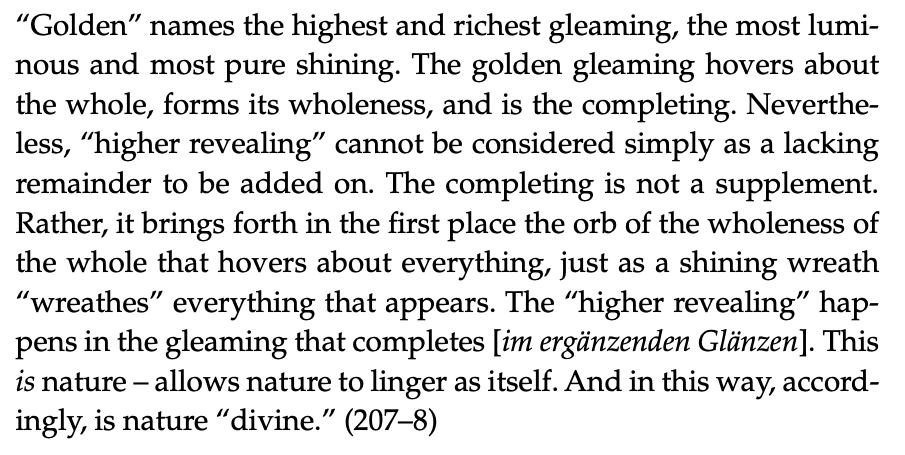Nature's "gleaming"
Nature is the unceasing emerging, lingering, passing away of all beings and things.
There is an essential joy that comes with our releasement to and harmonizing with the Being-way.

Nature (Being) shows itself as the gleaming “whole” that allows all beings to be and may be likened to a “shining wreath” that “wreathes everything that appears.” As this radiant “orb of the wholeness of the whole,” Nature (Being) is the “divine,” the holy.
The distinction between Nature and the landscape
Nature does not just shine, it gleams. But the landscape is not nature itself.
These images of the landscape are resplendent, but Heidegger cautions us: “Yet the landscape is not yet nature itself.
Landscape, gathered around human beings and inclined toward them, indeed lets appear nature in an initial gleaming” (206).
Note the distinction: the “landscape” (Landschaft) is not “nature itself” (Natur selbst). What Heidegger is articulating here should be very familiar to us; it is another saying of the “ontological difference” between beings and Being itself!
he readily admitted in later reflections that all previous Western philosophy had recognized and thematized in one way or another a “difference,” but he insisted that this was no more than a derivative “difference,” a difference in the realm of “beings,” and not the primordial and fundamental Differenz (Unterschied, Unter-Schied) between Being – the temporal letting, giving, granting way itself – and beings, that is, all that issues forth from out of the Being-way.
Nature, “in an initial gleaming,” lets shine forth everything that belongs to the landscape.
“The landscape with the multiplicity of its images can let appear ‘simple nature’ only because the landscape gleams from out of nature, which, as the ‘simple,’ is of divine essence”
The untold abundance of luminous “images” of the landscape show themselves to us; they shine forth to us; they open to us and address us – but that wherein and whereby everything is manifest to us is Nature (Being). Furthermore, this allowing, letting, giving, granting of beings that is Nature (Being) is itself manifest to us in a unique way – it is precisely the higher revealing (appearing, manifesting) that is glimpsed and named by Hölderlin in the poem.
Nature itself offers the evidence of – shows to us – this more elemental temporality in the way, for example, that buds appear on trees in the dead of winter in recollection of summer and in anticipation of spring. The “gleaming” of Nature itself (Being itself) “reveals” this to us: “The gleaming of nature is a revealing in which ever already the whole of the year shines throughout and thus constantly anticipates the individual times of the year.”
“The ‘bright image’ is the shining look of the autumnally completed year. Yet the whole of this completion ‘lives’ as one single image that is formed, that is, shows itself to non-sensuous seeing as ‘golden splendor,’ which hovers about everything and thus appears as ‘the whole meaning’” (207). ...his meaning appears to be that Nature (the One, the Simple, Being), which unfolds the landscape (all beings), manifests itself to us in a special manner that is different from the way that discrete things are manifest to us. Nature (Being) shows itself to us, but not as a being, not as something in the landscape. Therefore, we “see” Nature (Being) differently from the way we “see” things. Not an ordinary seeing or perception, but a special “seeing” that glimpses the “whole” process of the unfolding of all things – the very presencing itself of everything. Presencing itself (Nature, Being) is a “golden splendor” that suffuses, bathes (“hovers about”) everything that is.
From Richard M Capobianco, Heidegger's Way of Being, Chapter 2. 'On Hölderlin On “Nature’s Gleaming”'.
See also
Holderlin, “The Merry Life” Holderlin, “The Stroll” Holderlin, "Contentment"